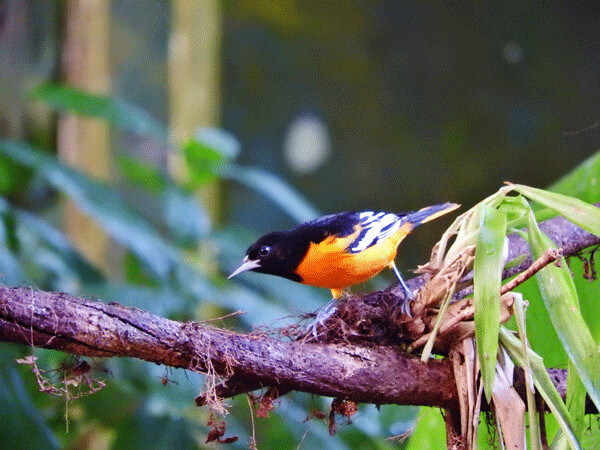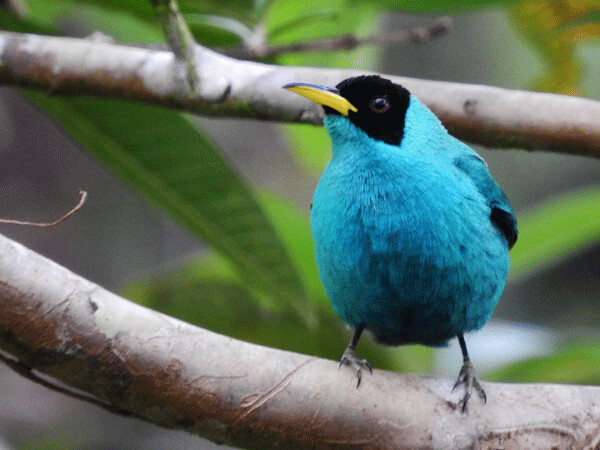Neotropical Migrants


Pineapple juice dripped down my chin. Sweat ran between my shoulder blades. And this was just at breakfast. The dining room at Selva Verde Lodge in the Sarapiquí region of north-central Costa Rica was bright and airy, with ceiling fans and open windows. It was still 85 degrees and humid. This beautiful lodge is situated on 500 acres of tropical forest that was rescued from logging in 1982, by Giovanna Holbrook, a visionary conservationist whose story reminded us of the Cable Natural History Museum’s founder, Mary Griggs Burke. Ms. Holbrook also created Holbrook Travel, the company that expertly arranged our trip.
By now, our Natural Connections in Costa Rica trip was about halfway into our nine-day adventure, and we knew the drill well. The breakfast buffet, which started with a pyramid of fresh pineapple, watermelon, and papaya, also contained generous portions of gallo pinto, scrambled eggs, odd-looking sausages, and fresh cheese. A different flavor of fresh fruit juice flowed like water each morning, and rich, dark, coffee filled our cups.
We were all comfortably dressed in shorts and sandals, with little need to worry about hauling around extra warm layers. Sun protection was our biggest concern, but thick leaves and shade structures abounded. Binoculars and cameras hung around our necks.
When I thought of home, I imagined the bare trees, freezing temperatures, absence of mosquitoes and ticks, and my larder full of blanched kale. Not bad, just different.
After joining the clean plate club, I went out on the deck of the dining room to have a peek at the bird feeders. A wooden platform held bananas the way we’d spread out corn up north. It was also covered with jewels. Vibrant green honeycreepers and shining honeycreepers fluttered almost like hummingbirds as they jockeyed for position. Passerini’s tanagers wore tuxedos of the blackest black with shimmering red sashes. The cloud of drably named blue-gray tanagers could have plucked their hues straight from the sky. Our chatter from behind our binocs included adjectives like “ridiculous!” “crazy!” “so bright!” and “it glows!”
When a striking black and orange bird swooped in for his turn, his colors fit right in, but I still did a double take. Instead of a strange new surprise, this was an old friend. Baltimore orioles are connoisseurs of ripe fruit, and can be lured into northern bird feeders with oranges and grape jelly. Since sunflower seeds and suet just won’t cut it for orioles, these neotropical migrants make an incredible journey to Central and South America for the winter.
We made that migration, too. Despite being ensconced in a jet plane, the flight from Minneapolis to Miami to San Jose was less than pleasant. Even if we hadn’t hit the worst turbulence of our lives in a Georgia thunderstorm, the plane was cramped and stuffy, and the security lines long. It’s amazing that such small birds can survive the journey. At least they get to stretch their legs and breathe fresh air!
The reality is, though, that many birds don’t survive migration. One study published by the British Ecological Society calculated that birds’ mortality rate is six times higher during migration than in their summer or winter habitat. Although these two perilous periods are relatively short, migration accounts for more than half of annual mortality.
So why risk it?
Well, staying in a northern winter isn’t much safer. Golden crowned kinglets are fantastically adapted winter residents of some of our coldest climates. Even so, part of their adaptation includes a higher than average reproduction rate in the summer to compensate for expected mortality in the winter.
Besides that, if you’re adapted to eating fruit or insects, or frogs you don’t have many options. Many of us can relate to the desire to follow “summer” year-round, with its associated warmth, sunshine, and fresh food.
The fruit was so enticing, in fact, that I went up for seconds. Now both the orioles and I had watermelon juice dripping down our chins. What a wonderful life it is for us neotropical migrants who survive the trip!
Special Note: Emily’s book, Natural Connections: Exploring Northwoods Nature through Science and Your Senses is here! Order your copy at http://cablemuseum.org/natural-connections-book/. Listen to the podcast at www.cablemusum.org!
